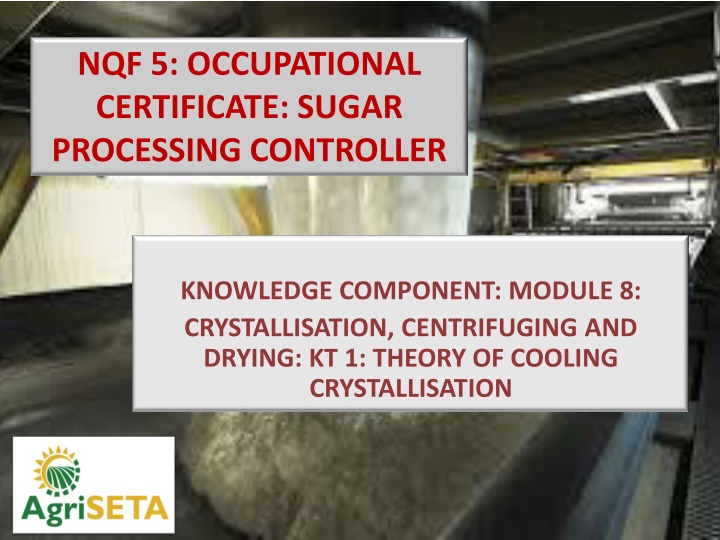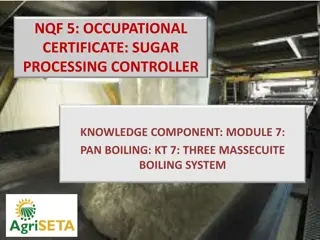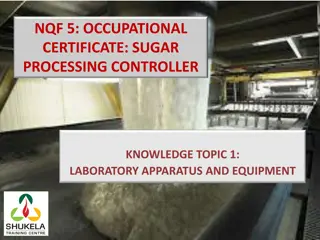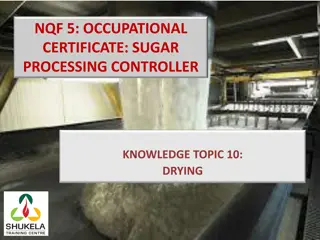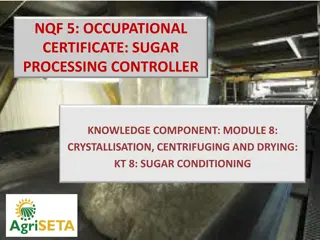NQF 5: OCCUPATIONAL CERTIFICATE: SUGAR PROCESSING CONTROLLER
Massecuite is slowly stirred as it cools, promoting crystal growth through controlled cooling rather than evaporation. Modern practices emphasize temperature drop for efficient crystallisation, crucial for maintaining high purity massecuites. Stirring is essential to prevent crystal fusion and optimize sucrose recovery. Learn why crystallisation is utilized differently in raw houses versus refineries.
Download Presentation

Please find below an Image/Link to download the presentation.
The content on the website is provided AS IS for your information and personal use only. It may not be sold, licensed, or shared on other websites without obtaining consent from the author.If you encounter any issues during the download, it is possible that the publisher has removed the file from their server.
You are allowed to download the files provided on this website for personal or commercial use, subject to the condition that they are used lawfully. All files are the property of their respective owners.
The content on the website is provided AS IS for your information and personal use only. It may not be sold, licensed, or shared on other websites without obtaining consent from the author.
E N D
Presentation Transcript
NQF 5: OCCUPATIONAL CERTIFICATE: SUGAR PROCESSING CONTROLLER KNOWLEDGE COMPONENT: MODULE 8: CRYSTALLISATION, CENTRIFUGING AND DRYING: KT 1: THEORY OF COOLING CRYSTALLISATION
Theory of Crystallisation Massecuite slowly stirred as it cools from strike temperature to approaching ambient (room) temperature. By stirring, massecuite kept in continual motion so that the sugar crystals continually come into contact with fresh mother liquor. Supersaturated sucrose will deposit itself on existing crystals instead of forming new nuclei (false grain). By slowly lowering the temperature the solubility of sucrose is reduced and crystallisation continues. Cooling increases or maintains the supersaturation coefficient to continue crystal growth. Crystallisation is achieved by cooling as opposed to evaporation as in a vacuum pan.
Theory of Crystallisation (cont.) Originally crystallisation attributed to retention time in the crystalliser. Modern practice advocates temperature drop as important and for this reason water cooling is now common practice. Crystallisation in motion is aimed at reducing sucrose losses (Improving exhaustion) The process before and after can affect the results. The work done in a crystalliser is no substitute for good pan boiling. Although good crystalliser work may compensate in a small way for poor pan boiling the best exhaustion can only be achieved by good work in both the pans and crystallisers.
Theory of Crystallisation (cont.) Crystallisers are always stirred Important for high purity massecuites that the stirrers do not stop Sugar crystals will settle to the bottom and fuse into a solid mass. If the stirring in A-crystalliser ceases for some reason a decision must be made within minutes to restart the stirrer immediately or to liquidate (empty) the crystalliser if the stirrer cannot be restarted.
Theory of Crystallisation (cont.) Crystallisation used extensively in a raw house, but not in a refinery. Why? Due to the presence of impurities the crystallisation rates in raw house vacuum pans is relatively low so crystallisation by cooling in crystallisers used to recover as much sucrose as possible. In refineries the massecuite purities are so high and the crystallisation rate so fast that all crystallisation is done in the pans. If refinery massecuites allowed to cool, would go rock hard . For batch pans the massecuites discharged from the pans dropped into a surge tank (strike receiver), from which the massecuite is fed to the crystalliser. A continuous vacuum pan discharges directly into its crystalliser.
Rate of Cooling and Crystallisation With low purity massecuites the crystallisation rate is slowed down by the high concentration of non- sugars relative to sucrose. At low temperatures it is thought to be the accommodation rate which slows down the crystallisation rate and not the diffusion rate. To ensure that the crystallisation rate is as fast as possible the following must be taken into account: Sufficient crystal surface Mainteance of sufficient supersaturation coefficient Sufficient cooling time
Rate of Cooling and Crystallisation (cont.) Sufficient crystal surface Provided there is sufficient crystal surface area the rate of crystallisation will keep pace with the cooling rate, so false grain formation is unlikely. Chance of forming false grain when a hot massecuite is dropped into a cold crystalliser. Maintenance of a sufficient supersaturation coefficient Crystallisation rate will slow down as the temperature decreases because of viscosity. Rate of cooling must be limited to keep the supersaturation of the mother liquor in the metastable zone to avoid false grain formation.
Rate of Cooling and Crystallisation (cont.) Sufficient cooling time Must be enough time to reduce the temperature and maintain a sufficient SSC and not to reduce the temperature too quickly and increase the SSC sufficiently to form false grain Typical massecuites residence times are as follows: A crystalliser 2 - 3 hours B crystalliser 7 - 8 hours C massecuite + 36 hours Exhaustion of C massecuite mother liquor is very important (much more than for A-massecuite) because C-molasses leaves the factory and the sucrose it contains is lost. In C-massecuites the crystallisation rate is slowest but it is the last chance to recover sucrose. C-massecuites therefore spend a long time in the crystallisers. A-massecuites should not be cooled much below 50 C especially when producing VHP sugar, since the increased mother liquor viscosity will require excessive amounts of wash water in the centrifugal. This wash water will cause some crystal dissolution and hence the benefit of crystallisation is lost.
High Purity Crystallisation Crystallisation used on high purity massecuites (i.e. A- massecuites) are used to maximise crystal size. If pan capacity is available then extra time spent boiling the massecuite will be more beneficial as regards increasing crystal size but if the A pan station is under stress then the crystallisers can be used to improve the crystal size. Crystallisation via cooling in crystallisers is no substitute for poor pan boiling. Because of the high purity mother liquor and low viscosity of A massecuites the cooling rates and crystallisation rates are much higher than low purity massecuites. Retention times can therefore be much shorter.
Low Purity Crytallisation The aim of all crystallisation operations is maximum exhaustion. The crystals must be separated from the mother liquor in the centrifugal and poor separation means recirculation of non-sugars to the high purity massecuites which is detrimental to further crystallisation. The crystallisation of low purity massecuites depends on: Crystallisation rate which depends on crystal content and surface area. Crystal size uniformity must therefore be optimised. Viscosity of molasses which will affect centrifugal performance. Good mother liquor exhaustion requires work to be done in the pans, crystallisers and centrifugal.
Low Purity Crytallisation (cont.) Crystal Size and Content Maximum crystal surface area is required as crystallisation rate is proportional to surface area. With high crystal content the layer of partially exhausted mother liquor surrounding the crystal will be thin and the crystals will be close together. Crystal surface area is inversely proportional to crystal size. Means that for a fixed crystal mass the surface area will be greater if the crystals are small. Small crystals are preferable, but separation of molasses in the centrifugal is not easy. This is made worse by viscosity. As the ideal requirements for crystallisation and separation are opposed to each other the boiled crystal size is a compromise. Uniform grain in the massecuite depends on the seeding of that pan. This is why true seeding must be carried out correctly. Crystal content also depends on massecuite purity.
Low Purity Crytallisation (cont.) Viscosity Viscosity increases as temperature decreases Thus will limit the degree of cooling that the crystalliser can handle and it will also affect the curing operation at the centrifugal. Viscosity increases with a decrease in purity. Final molasses can have a viscosity up to 400 times greater than a saturated sucrose solution under the same conditions. Viscosity will vary according to the nature of the impurities. Viscosity is the limiting factor for crystallisation (and hence exhaustion) in C-massecuites. In addition, viscosity also affects centrifugal performances.
